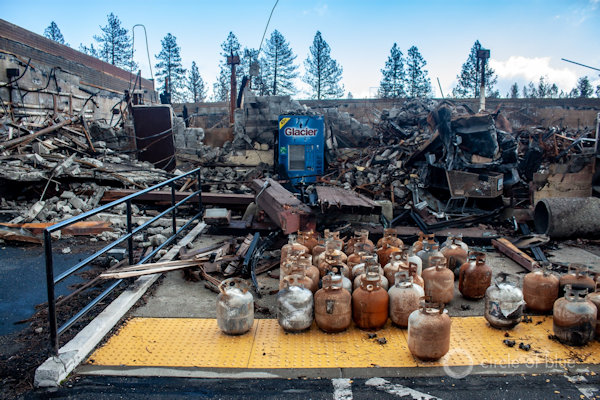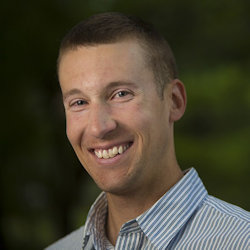SEJournal Online is the digital news magazine of the Society of Environmental Journalists. Learn more about SEJournal Online, including submission, subscription and advertising information.
 |
 |
| A Safeway grocery store in Paradise’s Old Town Plaza, reduced to rubble by California’s Camp Fire. It was one of several stories the author was able to produce on a grant from the Society of Environmental Journalists. Photo: Brett Walton/Circle of Blue. |
FEJ StoryLog: One Grant, Multiple Stories
By Brett Walton
Outstanding environmental reporting — the sort that turns heads and commands attention — is rooted in place. The difficult part: getting to that place. But once on the ground, the stories can multiply.
In the winter of 2019, I secured a Fund for Environmental Journalism, or FEJ, grant from the Society of Environmental Journalists to report on the struggles of California’s small drinking water systems and the state’s efforts to merge them with larger, better-run neighboring utilities. “Arranged marriages,” I called the process.
Between submitting the application
and being awarded the grant, I
learned of another small water
system with an unusual problem.
I had proposed a story set in Kern County, located in the southern part of the Central Valley. But between submitting the FEJ application and being awarded the grant, I learned of another small water system with an unusual problem, hundreds of miles north.
Several months before my trip, the city of Paradise in the Sierra Nevada foothills had burned to the ground during the Camp Fire, the deadliest and most destructive wildfire in state history. The city’s water system, serving a ghost town at that point, still had bills to pay but no customers providing revenue. Plus, the fire contaminated the city’s water distribution system with toxic volatile chemicals like benzene.
When planning a reporting trip, I usually include a couple days of unscheduled time. The buffer is useful if an interview has to be rescheduled or if the weather is frightful. I decided to use an unscheduled day to report the second story, “After Paradise Burned.” It was a whirl.
A productive detour
I booked an interview with California’s head drinking water regulator for the hour immediately after my plane touched down in Sacramento. After the interview, I drove an hour and a half north to Paradise, taking pictures before sunset of charred vehicles and obliterated home sites.
The following day, I interviewed the city water manager, toured the damaged facilities, recorded video, attended a water utility board meeting and watched the few remaining residents pick up cases of bottled water.
From the day and a half in
Paradise, I produced two stories, a
photo essay and a podcast interview
with the water manager.
The next morning I headed six hours south, to Bakersfield, for the main portion of my trip. The detour was worth it. From the day and a half in Paradise, I produced for Circle of Blue two stories, a photo essay and a podcast interview with the water manager.
That’s in addition to the story I had initially pitched for the grant, reported from Bakersfield: the feature on California’s push to consolidate small water systems,"In Bid for Cleaner Water, California Seeks Arranged Utility Marriages."
Finishing touches, lessons learned
 |
The FEJ grant not only catalyzed my reporting but it helped put the finishing touches on a third pending project on household water debt.
Just before the pandemic I was working on a months-long investigation of household water debt in the United States. The accumulation of unpaid bills can lead city utilities to shut off water to a home. There had been much reporting on debt-related shutoffs, but no national-level reporting on the size of those debts and how many households might be affected.
My project focused on a dozen of the country’s largest cities. I had gathered the data and completed the field reporting, returning from Chicago the week before the nation locked down.
For the story to stand out we needed striking photos of aging water systems that were causing the price of water to soar and of the people affected by water debt.
Air travel was out of the question. But the FEJ grant allowed us to hire photographers in Chicago and Houston, two cities featured in the story, to provide images complementing the text and graphics for “Water Debt.”
An extra day in the field is, on the margin, not a huge additional cost. So be sure to account for that buffer when outlining your reporting budget. Those days might be superfluous. But they might also be a spark of discovery.
Everyone likes getting something extra, especially grantmakers. Not every project can yield multiple stories, but keeping a lengthy list of potential stories can help you turn one into two when you’re in the right area at the right time.
Brett Walton writes about fresh water and all of its connections for the nonprofit news agency Circle of Blue. He also writes the Federal Water Tap, a weekly digest of U.S. government water news. His work has been supported by the Society of Environmental Journalists, the Institute for Journalism and Natural Resources, the National Press Foundation, the Pulitzer Center on Crisis Reporting and The Water Desk. His last piece for SEJournal examined coronavirus and legionnaires’ disease.
* From the weekly news magazine SEJournal Online, Vol. 8, No. 32. Content from each new issue of SEJournal Online is available to the public via the SEJournal Online main page. Subscribe to the e-newsletter here. And see past issues of the SEJournal archived here.












 Advertisement
Advertisement 



